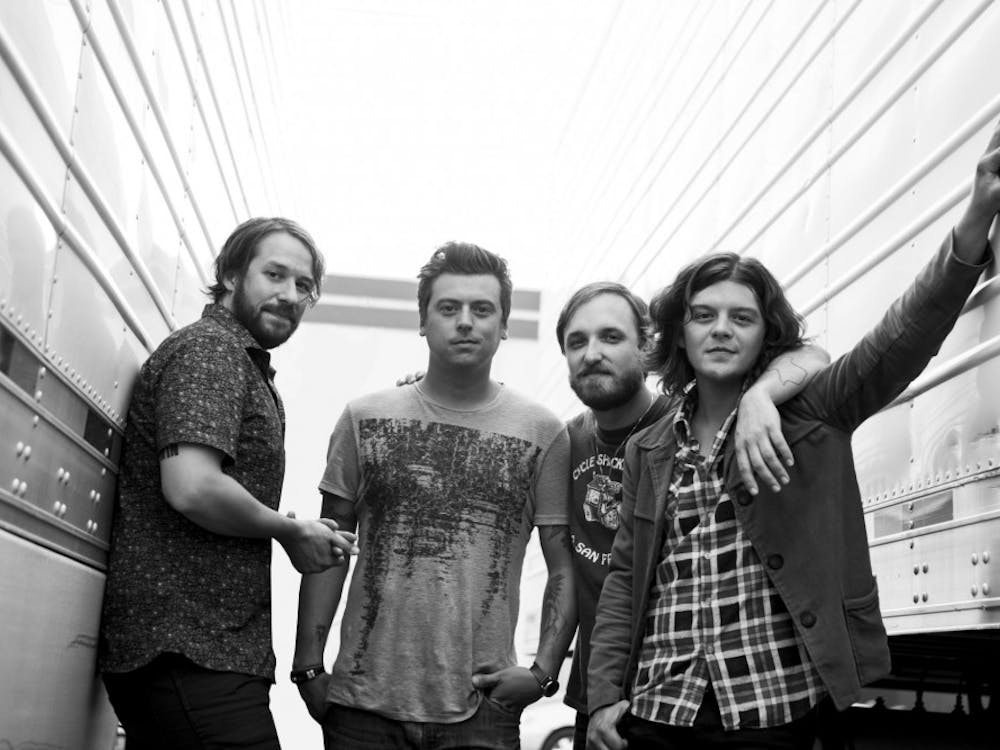Construction continues to transform the campus, students adapt to the change
By Clare Shreve
Change is in the air, even at the University of Portland, where steel clanging, piles of rebar and chain-link fencing galore are just a few sights familiar to students, faculty and staff. With four construction projects underway - one new dormitory, a dining hall expansion, a bell tower and a refurbished engineering building - a new face on the University is emerging.
New dorms
On the north side of campus, construction is nearly complete on two new dorms that will ?be home for 312 students. "The dorms should be furnished by August first in order for staff to move in," Paul Luty, director of facilities planning, said.
As of Friday, despite a week delay in December due to weather, construction of Fields and Schoenfeldt Halls is 90 percent complete.
The structural steel and concrete of the building is in place, except for three sections of the main stairway, Luty said. The roof is also in place. Windows ?are installed in the north wing ?and brickwork is visible on the north corner of the building. Sheetrock will go up at the ?north end wing. Landscaping should also begin in the coming weeks.
Construction should be complete by the end of July, which is good news for students, particularly those who live in the University Village near the construction site.
The noise should be less interruptive than last semester. The lift for the bricklaying will be noisy but most of the noise will come from inside the dorm, Luty said.
The Commons
Since more students are anticipated to live on campus next year in the new dorms, ?the Commons is expecting to ?feed an additional 200 hungry college mouths. The first of two phases of construction began Jan. 2 for expansion of the dining hall.
The first phase of construction focuses on providing more seating for students. Currently the Commons holds large ?circular tables and smaller two to three person square tables bordering the room. The new Commons is expected to have a larger variety of seating, including booths, small and large group tables and outside patio seating.
Other changes to the Commons include a new entrance, new restrooms and a multi-functioning boardroom. These changes, as part of the first phase, expect to be completed in July.
A lack of funding is delaying the second phase of the expansion, which is targeted to include new kitchen equipment. Nonetheless, Kirk Mustain, Bon Appetit general manger, said efforts to ease the impact on students are underway.
"We're talking about ways to make this a continual dining experience," Mustain said. Extended hours may be implemented so that there are fewer conflicts with class times and more availability of meals for students.
The food offered through Bon Appetit will remain ?mostly the same with few alterations. Extended options for the grab-and-go area will ?be created for students who ?don't have time between classes ?to sit down for a meal. Mustain said the food purchased at this ?station will be a part of a meal equivalency system, counting ?as one meal from the meal plan.
The Commons is also looking at changing the food it serves.
"We might change scheduling on some of people's favorite entrees," Mustain said. For instance, there could be more quick-serve items on the busiest of days. Meals that take more time to prepare will be scheduled for calmer days in order to keep the lines moving.
Mustain said that Bon Appetit is also considering placing wireless Internet in the Commons.
Observatory
While all this construction signals the University's future, the care has also been extended to the school history. The school observatory, just north of the Commons, was demolished last week but the more than 60-year-old telescope inside the building has been moved to the vehicle garage in the maintenance building for safe keeping, the Rev. Ron Wasowski, C.S.C., said.
Demolition of the Merle Starr Observatory began Jan. 21. The telescope that was housed in the observatory is being taken out, and taken apart. The goal of the University, and Wasowski, is to keep the mirrors of the telescope safe.
The mirrors are unique. They were fashioned after the Hale telescope on Mount Palomar, in southern California. The Hale telescope is the first large telescope ever built. The mirrors in Hale have a 200-inch diameter. UP's telescope was made on a tenth of an inch scale, giving our telescope's mirrors a diameter of 20 inches. The telescope was made in the mid-1940s and there were only three of them made.
"If the other two exist nobody knows what happened to them," Wasowski said.
The hope is not only to protect what may be a completely unique telescope, it is also to make it more portable and accessible for students to use.
Wasowski said the base would be changed to a lightweight aluminum and attached to a wheeling apparatus. This would insure its portability out onto the quad for student viewings.
Shiley Hall
Like the Commons, Shiley Hall, the new engineering building, has a projected finish date of July.
The largest classroom, which holds more than 80 students, located on Shiley Hall's third floor will be finished by the end of February. The gallery space located on the second floor is almost completed, just needing final touches of the wood paneling. The gallery will remain closed for the semester to "keep it fresh for the dedication," Luty said. The space will soon be filled with exhibits.
Many areas of Shiley are close to completion. Professors' offices are nearly complete, but some of the professors who moved their offices to the Mehling Hall basement to escape the noise will wait until all construction is complete to return.
Even with the near-complete classroom and gallery there is ?still a lot of work to be done between now and July. All of the first ?floor classrooms and 10 second floor offices need to be ?constructed as a part of the existing building.
Bell Tower
The construction site for the new bell tower was quickly established between the Chapel of Christ the Teacher and St. Mary's Lounge, displacing the Virgin Mary statue from her normal, shaded, rock-filled sanctuary near the Chapel.
"What's fenced in now will be as large as the construction site gets," Luty said. "They are forming the concrete off-site." Pre-cast panels of concrete will be laid once the space has been cleared of unnecessary dirt. Once the concrete has been laid, the UP campus can say goodbye to the concrete trucks around the south part campus. The bells, a total of 14, have been ordered and are being cast.
The statue of Mary may feel somewhat dwarfed by her new 95-foot high companion, not to mention the 12 by 12 foot cross atop the tower when she returns. LED lights, which emit less heat and last longer, will be placed near the top of the tower to highlight the cross.
The large rocks that were original to the spot will be back, but in a different configuration. The original 12 cherry trees that were removed in making way for the bell tower were planted by alum George Galati and his family in honor of one of his daughters. Consequently some of the tree trunks will be saved and used to make family mementos to remember her.
Twelve new cherry trees will be planted in their place.







